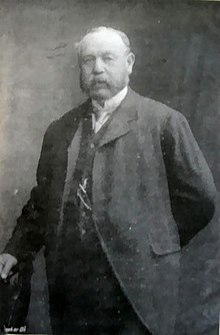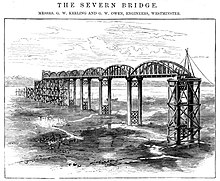| George Backhouse Witts | |
|---|---|
 | |
| Born | 1846 (1846) Winchcombe, Gloucestershire, England |
| Died | 6 September 1912(1912-09-06) (aged 65–66) Leckhampton, England |
| Nationality | British |
| Occupations |
|
| Notable work | Archaeological Handbook of the County of Gloucester (1883) |
George Backhouse Witts (1846 – 6 September 1912) was a British civil engineer and archaeologist who specialised in the prehistoric barrows of Gloucestershire. His Archaeological Handbook of the County of Gloucester (1883), the first such survey of the county, remained a standard work until the mid-20th century.
He later became a notable figure in the life of Leckhampton in Gloucestershire and as the local magistrate was once required to read the Riot Act on Leckhampton Hill to disperse a crowd of protesters intent on property damage.
Early life and family
George Backhouse Witts was born in Winchcombe, Gloucestershire, in 1846 to Sophia Witts and the clergyman Edward Francis Witts, who was rector of Upper Slaughter in Gloucestershire as was his father the diarist Francis Edward Witts. George's father and grandfather were Lords of the Manor of Upper Slaughter. He was educated at the private Rugby School in Warwickshire.
In 1878, Witts married Sybil Catharine Vavasour in Cheltenham. Their daughter was Sybil Holdsworth Witts.
Career


Witts qualified as a civil engineer and worked on the construction of the Cheltenham to Bourton-on-the-Water railway line as well as other railway projects in Gloucestershire such as the first Severn Railway Bridge.
He was a keen amateur archaeologist and a founding member of the Bristol and Gloucestershire Archaeological Society, specialising in the prehistoric barrows of Gloucestershire. His Archaeological Handbook of the County of Gloucester (1883) was the first such survey of the county, and remained a standard work until the mid-20th century.
Witts was heavily involved in local affairs and was chairman of Leckhampton council which set up a defence fund for the "Leckhampton Stalwarts" who had been arrested following the destruction of a newly built cottage that they claimed blocked their ancient right of way on to Leckhampton Hill. He was also the local magistrate and in 1906, during a later period of disorder on the hill, was forced to read the Riot Act to disperse a crowd who were intent on further damage to property.
His other activities included the Gloucestershire Rifle Volunteers, in which he was a lieutenant, being honorary secretary of the Cotswold Hunt, and participation in the Ancient Order of Foresters. He was a churchgoer and gave talks on the local area after which he would sometimes entertain the audience with Gloucestershire folk songs such as "The stwuns that built George Ridler's oven", a song with a secret meaning originally known only to members of The Gloucestershire Society.
Death and legacy
George Witts died on 6 September 1912. His address at the time of his death was Hill House, Leckhampton, Cheltenham. Probate was granted to his daughter Sybil Holdsworth Witts, spinster, and Edward Clare Sewell, solicitor. He received an obituary in The Gloucester Journal.
Documents from Witts, and artefacts that he excavated, form the G. B. Witts Collection at the Wilson Museum in Cheltenham.
Selected publications
- Archaeological Handbook of the County of Gloucester, Being an Explanatory Description of the Archaeological Map of Gloucester, by the same author &c. G. Norman, Cheltenham, 1883.
References
- George Barkhouse Witts England and Wales Birth Registration Index, 1837–2008. Family Search. Retrieved 21 April 2019. (subscription required)
- Parishes: Upper Slaughter. British History Online. Retrieved 21 April 2019.
- ^ George Backhouse Witts (1846–1912). The Cheltenham Trust. Retrieved 21 April 2019.
- George Backhouse Witts England and Wales Marriage Registration Index, 1837–2005. Family Search. Retrieved 21 April 2019. (subscription required)
- ^ George Backhouse Witts British Newspaper Archives, Obituaries. Family Search. Retrieved 21 April 2019. (subscription required)
- The Engineer, 5 January 1877, p. 15.
- Recent History. Friends of Leckhampton Hill and Charlton Kings Common. Retrieved 22 April 2019.
- "Leckhampton Hill Riots" by Andy Gilbert, Friends of Leckhampton Hill & Charlton Kings Common Newsletter, No. 5, September 2001, p. 4.
- Leckhampton Local History Society. (2015) The Leckhampton Riots 1902 and 1906. Leckhampton: Leckhampton Local History Society.
- The Planting of the Coronation Oak at Leckhampton 1902. Eric Miller, Leckhampton Local History Society. Retrieved 22 April 2019.
- Gibbs, J. Arthur (1929) A Cotswold Village, or, Country Life and Pursuits in Gloucestershire. 3rd edition. London: Jonathan Cape. pp. 73–76 & 313–316.
- 1912 Probate Calendar. p. 286.
Further reading
- "The Rage to Rake in Dust and Ashes: A Socio-economic Context for the Excavation of Prehistoric Barrows in the Nineteenth Century" by Julien Parsons, Archaeological Journal, Vol. 163 (2006), No. 1, pp. 233–263.
External links
![]() Media related to Archaeology of Gloucestershire at Wikimedia Commons
Media related to Archaeology of Gloucestershire at Wikimedia Commons